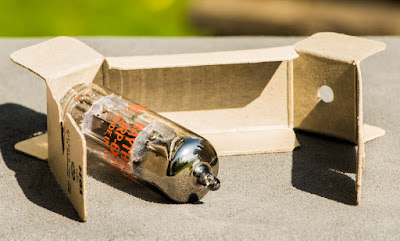After last months huge transmitting triode, this months tube will be at the opposite end of the size spectrum, the 6X4.
The 6X4 is an indirectly heated full wave rectifier tube for small currents. Ideally suited for preamplifiers.
 The 6X4 is a miniature 7 pin tube. The base diagram is shown on the left. It has a 6.3V heater which consumes a very modest 0.6A. The maximum DC output current is specified as 77mA. Due to the limited peak inverse voltage capability the maximum reachable DC output voltage stays below 400V. As such the tube is ideally suited for situations in which only small current is needed for example preamplifiers, separate supplies for driver stages in power amps or bias supplies. With it's small size and very modest heater power it can be mounted pretty much anywhere. Even inside a chassis is possible with the proper ventilation. The tube is only 6cm high and has less than
The 6X4 is a miniature 7 pin tube. The base diagram is shown on the left. It has a 6.3V heater which consumes a very modest 0.6A. The maximum DC output current is specified as 77mA. Due to the limited peak inverse voltage capability the maximum reachable DC output voltage stays below 400V. As such the tube is ideally suited for situations in which only small current is needed for example preamplifiers, separate supplies for driver stages in power amps or bias supplies. With it's small size and very modest heater power it can be mounted pretty much anywhere. Even inside a chassis is possible with the proper ventilation. The tube is only 6cm high and has less than 20mm diameter. Being directly heated it provides a delayed start of the output voltage with a slow ramp. The 6X4 does not seem to be very popular any more among amplifier builders. I myself am guilty of ignoring it so I cannot share any practical experience with this tube. But there is no reason why it wouldn't perform well. If space is limited and not much heater power is available this tube can be just the ticket. NOS tubes can still be found and also finding good quality 7 pin sockets is not a problem. Since I never used 6X4s for any project, I did not stock up many of them. I only have a few ruggedised 6X4W tubes made by Raytheon. See the datasheet for all technical details. Quite remarkable is the shock resistance which is stated up to 700G(!) for the 'W' version.
20mm diameter. Being directly heated it provides a delayed start of the output voltage with a slow ramp. The 6X4 does not seem to be very popular any more among amplifier builders. I myself am guilty of ignoring it so I cannot share any practical experience with this tube. But there is no reason why it wouldn't perform well. If space is limited and not much heater power is available this tube can be just the ticket. NOS tubes can still be found and also finding good quality 7 pin sockets is not a problem. Since I never used 6X4s for any project, I did not stock up many of them. I only have a few ruggedised 6X4W tubes made by Raytheon. See the datasheet for all technical details. Quite remarkable is the shock resistance which is stated up to 700G(!) for the 'W' version.The tube in it's full glory:
Views from other angles:
This tube came in a bland military box:
It has a nice internal support for secure shipping:
Some details of the tube:
The base:
The top:
Here one of the extra support rods is visible which braces the internals:
The two plates are very close to each other so that they almost seem to be a single piece:
To examine the construction in detail I opened one up:
The top mica:
The holder of the getter:
Very rugged construction indeed:
The bottom mica:
The heater wire coming out of the cathode:
The two support rods.
Now the cathode is visible between the two plates:
The cathode:
One of the plates:
A fine piece of vacuum tube engineering!
Best regards
Thomas









































As a young lad I built a mono phono amp using a 6x4 rectifier with 6av6 and 6aq5. Worked well.
ReplyDeleteThis rectifier is not much use for anything, & prices have reached stupid proportions.
ReplyDeleteFew people appear to realise the best thing to do with it is to precede it with a pair of silicon rectifier diodes then use the 2 diodes in this valve in parallel for the DC supply.
This way the modest current limits can be totally disregarded, and the thing used for a gentle warm up of the HT lines, as well as getting a much lower voltage drop.
Adding to this, you can disregard the original PIV limits as well as the low filter capacitor values (placing them BEFORE the valve, with a smaller value after.)
The 6X4 then provides a filter for any supply noise, and can even be run with the winding from a 5V heater transformer with no harm whatever.
I have tried it, it works.
It is of use in low current applications like preamps and I don't see sky rocketed prices either available for 5-6bucks. Choose a tube rectifier which is designed for the purpose you intend it for. If you want to use silicon fine, but no reason to criticise this tube.
Deletesimple 2 silicon diodes for rectification, 35W4 as warm up device voltage drop 15V at 100m/a, so you can run them at anything up to 600V easy.
ReplyDeleteThey state max smoothing cap = 40uF as they handle much higher peak currents.
If you use the 6X4 with the diodes in parallel preceded by silicon rectifiers voltage drop = 30V but they state max smoothing cap = 10uF.
35W4 is a much better rectifier. (damper diode).